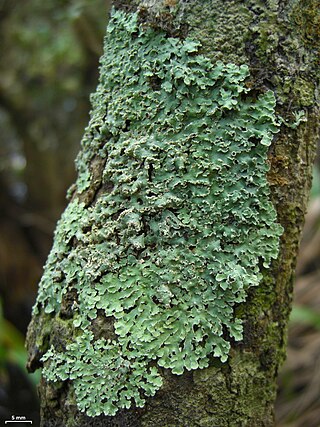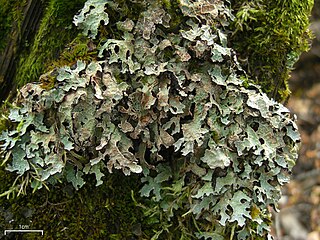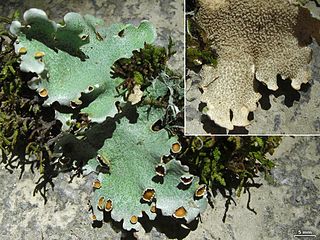
Anaptychia is a genus of lichen-forming fungi in the family Physciaceae. Anaptychia species are foliose lichens. They have brown, thin-walled spores with a single septum, and a prosoplechtenchymatous upper cortex.

Physcia is a genus of lichen-forming fungi in the family Physciaceae. The widely distributed genus contains about 80 species. The genus is cosmopolitan, and has been extensively studied in various regions in the past several decades, with significant biodiversity in South America identified as a central diversity hotspot. Physcia species are foliose, lobate lichens that grow with a loose to close appressed habit. Their upper surface is typically whitish, pale greenish, green-grey, or dark grey in colour. The thallus colour remains relatively unchanged when moistened. Physcia lichens typically grow on bark, on wood, or rock, although they have occasionally been recorded dwelling on man-made structures. They thrive in nutrient-rich environments and are expanding rapidly in urban areas of the United Kingdom previously affected by SO2 pollution.

Phaeophyscia is a genus of lichen-forming fungi in the family Physciaceae.

Esslingeriana is a fungal genus in the family Parmeliaceae. The genus is monotypic, containing the single foliose lichen species Esslingeriana idahoensis, commonly known as the tinted rag lichen. It is found in northwestern North America.

Lichens are symbiotic organisms made up of multiple species: a fungus, one or more photobionts and sometimes a yeast. They are regularly grouped by their external appearance – a characteristic known as their growth form. This form, which is based on the appearance of vegetative part of the lichen, varies depending on the species and the environmental conditions it faces. Those who study lichens (lichenologists) have described a dozen of these forms: areolate, byssoid, calicioid, cladoniform, crustose, filamentous, foliose, fruticose, gelatinous, leprose, placoidioid and squamulose. Traditionally, crustose (flat), foliose (leafy) and fruticose (shrubby) are considered to be the three main forms. In addition to these more formalised, traditional growth types, there are a handful of informal types named for their resemblance to the lichens of specific genera. These include alectorioid, catapyrenioid, cetrarioid, hypogymnioid, parmelioid and usneoid.

Lichen morphology describes the external appearance and structures of a lichen. These can vary considerably from species to species. Lichen growth forms are used to group lichens by "vegetative" thallus types, and forms of "non-vegetative" reproductive parts. Some lichen thalli have the aspect of leaves ; others cover the substrate like a crust, others such as the genus Ramalina adopt shrubby forms, and there are gelatinous lichens such as the genus Collema.
Hypogymnia congesta is a rare species of foliose lichen in the family Parmeliaceae. Found in China, it was formally described as a new species in 2003. The lichen grows on the bark and wood of conifers and bamboo. Hypogymnia congesta has a brown to brownish-grey foliose thallus measuring up to 8 cm (3.1 in) long or broad, with a cartilage-like texture. The lichen is chemically distinct, containing physodic acid and virensic acid; the latter substance is otherwise unknown from genus Hypogymnia.

Pyxine subcinerea is a species of foliose lichen in the family Caliciaceae. It has a pantropical distribution, and typically grows on bark, but less commonly on rocks. The lichen is characterised by its yellow medulla, soralia on the margins on the lobes that make up the thallus, and the presence of the chemical lichexanthone in the cortex.
Punctelia constantimontium is a species of foliose lichen in the family Parmeliaceae. Its range includes South America, Africa, and Mexico, where it grows on bark and twigs.
Punctelia colombiana is a species of corticolous (bark-dwelling) and foliose (leafy) lichen in the family Parmeliaceae. It is found in South America.

Punctelia graminicola is a species of foliose (leafy) lichen in the family Parmeliaceae. It grows on rocks, and, less frequently, on bark in North America, South America, and East Africa. It has a blue-grey thallus measuring up to about 15 cm (6 in), covered with tiny pores called pseudocyphellae. Sometimes the lichen forms small lobes that project out from the surface. Fruiting bodies are uncommon in this species; if present, they resemble small cups with a brown internal disc measuring 3–10 mm (0.1–0.4 in) in diameter. A lookalike species, Punctelia hypoleucites, is not readily distinguishable from Punctelia graminicola by appearance or habitat alone; these species can only be reliably differentiated by examining the length of their conidia.
Parmelia ambra is a fossilised species of foliose lichen in the family Parmeliaceae. Found in Dominican amber and described as a new species in 2000, the fossil has been used in subsequent studies of lichen evolution.

Parmelia barrenoae is a species of foliose lichen in the large family Parmeliaceae. It was formally described as a new species in 2005. Before this, it was lumped together as one of several lichens in the Parmelia sulcata group—a species complex of genetically distinct lookalikes. Parmelia barrenoae is widely distributed, occurring in Europe, western North America, Africa, and Asia.
Sticta viviana is a species of corticolous (bark-dwelling), foliose lichen in the family Peltigeraceae. It is found in Colombia, where it grows on the branches and twigs of shrubs and treelets in high-elevation páramo habitat.
Leptogium compactum is a species of corticolous (bark-dwelling), foliose lichen in the family Collemataceae. Found in northwestern North America, it was formally described as a new species in 2016 by Daphne Stone, Frances Anderson, and James Hinds. It is distinguished from related Leptogium species by the tightly packed hyphae in the medulla; this characteristic internal anatomy is alluded to in the species epithet compactum.
Klauskalbia is a genus of lichen-forming fungi in the family Physciaceae. It has four species of foliose lichens.
Rusavskia drevlyanica is a species of saxicolous (rock-dwelling) lichen in the family Teloschistaceae. Described as a new species in 2020, it is found in the East European forest steppe of Ukraine.

Lobariella reticulata is a species of foliose lichen in the family Peltigeraceae. It is found in Colombia.

Pyxine petricola is a species of saxicolous (rock-dwelling), foliose lichen in the family Caliciaceae. The distribution of the lichen includes Australia, East Africa, North and Central America, and the Philippines.
Teloschistes spinosus is a species of corticolous (bark-dwelling), fruticose lichen in the family Teloschistaceae. It is found in Australia and New Zealand.










